Practice Free AZ-204 Exam Online Questions
You are developing an application to manage shipping information for cargo ships. The application will use Azure Cosmos D8 for storage.
The application must run offline when ships are at sea The application must be connected to Azure when ships are in port.
Which Azure Cosmos D8 API should you use for the application?
- A . Core
- B . MongoDe
- C . Cassandra
- D . Gremlin
You are developing an application to manage shipping information for cargo ships. The application will use Azure Cosmos D8 for storage.
The application must run offline when ships are at sea The application must be connected to Azure when ships are in port.
Which Azure Cosmos D8 API should you use for the application?
- A . Core
- B . MongoDe
- C . Cassandra
- D . Gremlin
DRAG DROP
You have a web app named MainApp. You are developing a triggered App Service background task by using the WebJobs SDK. This task automatically invokes a function code whenever any new data is received in a queue.
You need to configure the services.
Which service should you use for each scenario? To answer, drag the appropriate services to the correct scenarios. Each service may be used once, more than once, or not at all. You may need to drag the split bar between panes or scroll to view content. NOTE: Each correct selection is worth one point.
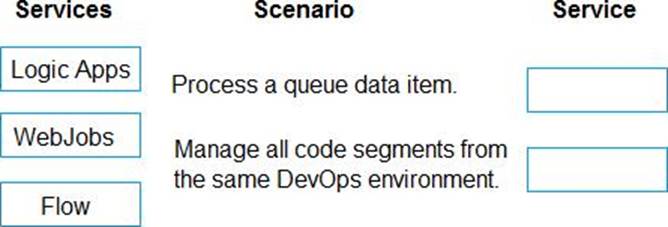
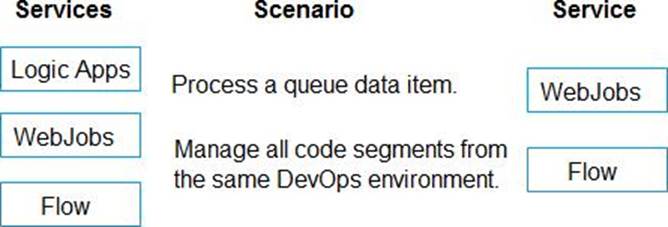
Explanation:
Box 1: WebJobs
A WebJob is a simple way to set up a background job, which can process continuously or on a schedule. WebJobs differ from a cloud service as it gives you get less fine-grained control over your processing environment, making it a more true PaaS service.
Box 2: Flow
Incorrect Answers:
Azure Logic Apps is a cloud service that helps you schedule, automate, and orchestrate tasks, business processes, and workflows when you need to integrate apps, data, systems, and services across enterprises or organizations. Logic Apps simplifies how you design and build scalable solutions for app integration, data integration, system integration, enterprise application integration (EAI), and business-to-business (B2B) communication, whether in the cloud, on premises, or both.
Reference: https://code.msdn.microsoft.com/Processing-Service-Bus-84db27b4
You are building a B2B web application that uses Azure B2B collaboration for authentication Paying customers authenticate to Azure B2B using federation
The application allows users to sign up for trial accounts using any email address
When a user converts to a paying customer, the data associated with the teal should be kept, but the user must authenticate using federation
You need to update the user in Azure Active Directory (Azure AD) when they convert to a paying customer
Which Graph API parameter is used to change authentication from one-time passé odes to federation?
- A . uscrFlowType
- B . Status
- C . invittdUstr
- D . resetRedemption
You are preparing to deploy an ASP.NET Core website to an Azure Web App from a GitHub repository.
The website includes static content generated by a script.
You plan to use the Azure Web App continuous deployment feature.
You need to run the static generation script before the website starts serving traffic.
What are two possible ways to achieve this goal? Each correct answer presents a complete solution. NOTE: Each correct selection is worth one point.
- A . Create a file named .deployment in the root of the repository that calls a script which generates the static content and deploys the website.
- B . Add a PreBuild target in the websites csproj project file that runs the static content generation script.
- C . Create a file named run.cmd in the folder /run that calls a script which generates the static content and deploys the website.
- D . Add the path to the static content generation tool to WEBSITE_RUN_FROM_PACKAGE setting in the host.json file.
AD
Explanation:
A: To customize your deployment, include a .deployment file in the repository root.
You just need to add a file to the root of your repository with the name .deployment and the content:
[config]
command = YOUR COMMAND TO RUN FOR DEPLOYMENT
this command can be just running a script (batch file) that has all that is required for your deployment, like copying files from the repository to the web root directory for example.
D: In Azure, you can run your functions directly from a deployment package file in your function app. The other option is to deploy your files in the d:homesitewwwroot directory of your function app (see A above).
To enable your function app to run from a package, you just add a WEBSITE_RUN_FROM_PACKAGE setting to your function app settings.
Note: The host.json metadata file contains global configuration options that affect all functions for a function app.
Reference: https://github.com/projectkudu/kudu/wiki/Custom-Deployment-Script
https://docs.microsoft.com/bs-latn-ba/azure/azure-functions/run-functions-from-deployment-package
HOTSPOT
You are developing an application that uses a premium block blob storage account. You are optimizing costs by automating Azure Blob Storage access tiers.
You apply the following policy rules to the storage account. You must determine the implications of applying the rules to the data. (Line numbers are included for reference only.)
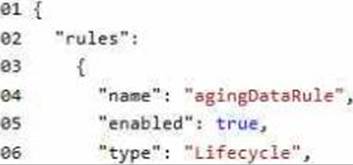

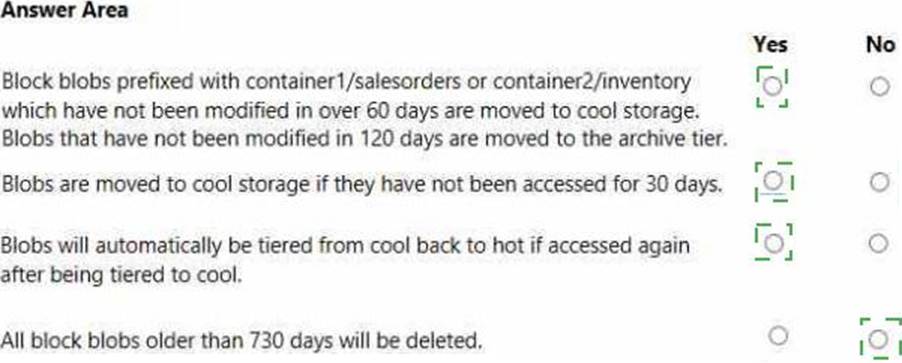
Explanation:
Note: This question is part of a series of questions that present the same scenario. Each question in the series contains a unique solution that might meet the stated goals. Some question sets might have more than one correct solution, while others might not have a correct solution.
After you answer a question in this section, you will NOT be able to return to it. As a result, these questions will not appear in the review screen.
You develop a software as a service (SaaS) offering to manage photographs. Users upload photos to a web service which then stores the photos in Azure Storage Blob storage. The storage account type is General-purpose V2.
When photos are uploaded, they must be processed to produce and save a mobile-friendly version of the image. The process to produce a mobile-friendly version of the image must start in less than one minute.
You need to design the process that starts the photo processing.
Solution: Trigger the photo processing from Blob storage events.
Does the solution meet the goal?
- A . Yes
- B . NO
B
Explanation:
You need to catch the triggered event, so move the photo processing to an Azure Function triggered from the blob upload
Note: Azure Storage events allow applications to react to events. Common Blob storage event scenarios include image or video processing, search indexing, or any file-oriented workflow.
Events are pushed using Azure Event Grid to subscribers such as Azure Functions, Azure Logic Apps, or even to your own http listener.
Note: Only storage accounts of kind StorageV2 (general purpose v2) and BlobStorage support event integration. Storage (general purpose v1) does not support integration with Event Grid.
Reference: https://docs.microsoft.com/en-us/azure/storage/blobs/storage-blob-event-overview
HOTSPOT
A company is developing a Node.js web app. The web app code is hosted in a GitHub repository located at https://github.com/TailSpinToys/weapp.
The web app must be reviewed before it is moved to production. You must deploy the initial code release to a deployment slot named review.
You need to create the web app and deploy the code.
How should you complete the commands? To answer, select the appropriate options in the answer area. NOTE: Each correct selection is worth one point.
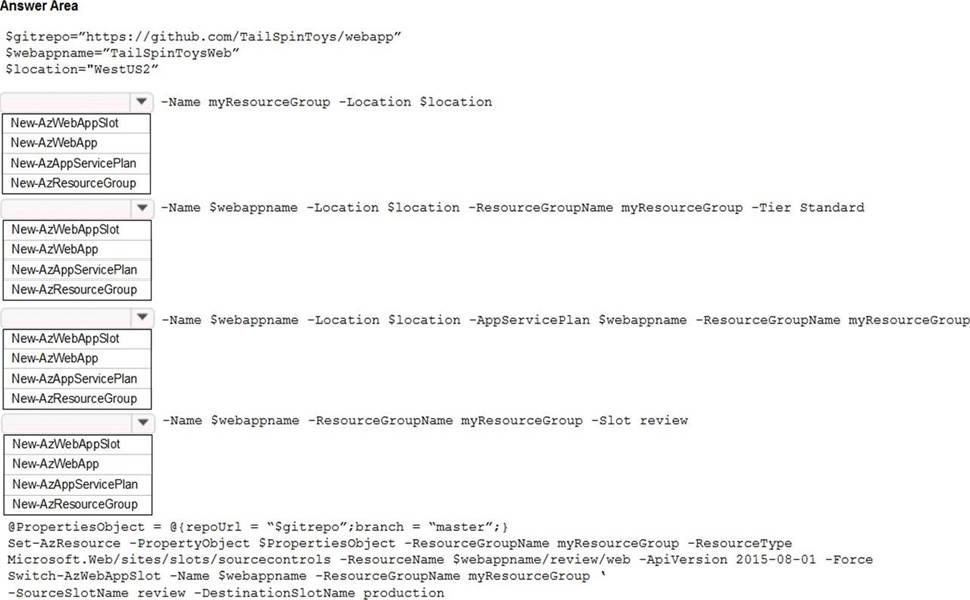
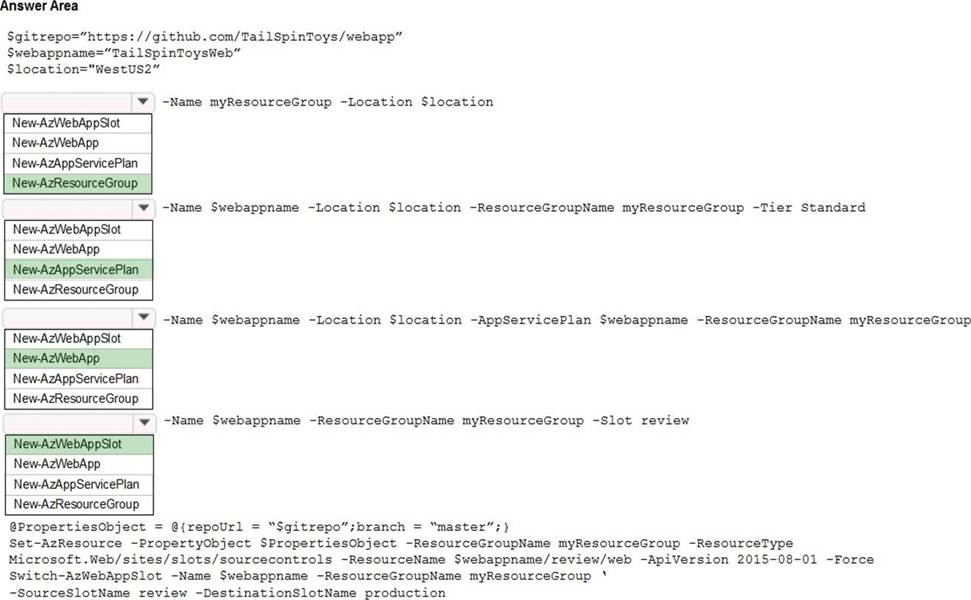
Explanation:
The New-AzResourceGroup cmdlet creates an Azure resource group.
The New-AzAppServicePlan cmdlet creates an Azure App Service plan in a given location
The New-AzWebApp cmdlet creates an Azure Web App in a given a resource group
The New-AzWebAppSlot cmdlet creates an Azure Web App slot.
Reference:
https://docs.microsoft.com/en-us/powershell/module/az.resources/new-azresourcegroup?view=azps-2.3.2
https://docs.microsoft.com/en-us/powershell/module/az.websites/new-azappserviceplan?view=azps-2.3.2
https://docs.microsoft.com/en-us/powershell/module/az.websites/new-azwebapp?view=azps-2.3.2
https://docs.microsoft.com/en-us/powershell/module/az.websites/new-azwebappslot?view=azps-2.3.2
HOTSPOT
A company is developing a Node.js web app. The web app code is hosted in a GitHub repository located at https://github.com/TailSpinToys/weapp.
The web app must be reviewed before it is moved to production. You must deploy the initial code release to a deployment slot named review.
You need to create the web app and deploy the code.
How should you complete the commands? To answer, select the appropriate options in the answer area. NOTE: Each correct selection is worth one point.


Explanation:
The New-AzResourceGroup cmdlet creates an Azure resource group.
The New-AzAppServicePlan cmdlet creates an Azure App Service plan in a given location
The New-AzWebApp cmdlet creates an Azure Web App in a given a resource group
The New-AzWebAppSlot cmdlet creates an Azure Web App slot.
Reference:
https://docs.microsoft.com/en-us/powershell/module/az.resources/new-azresourcegroup?view=azps-2.3.2
https://docs.microsoft.com/en-us/powershell/module/az.websites/new-azappserviceplan?view=azps-2.3.2
https://docs.microsoft.com/en-us/powershell/module/az.websites/new-azwebapp?view=azps-2.3.2
https://docs.microsoft.com/en-us/powershell/module/az.websites/new-azwebappslot?view=azps-2.3.2
HOTSPOT
You are developing an ASP.NET Core time sheet application that runs as an Azure Web App. Users of the application enter their time sheet information on the first day of every month.
The application uses a third-party web service to validate data.
The application encounters periodic server errors due to errors that result from calling a third-party web server. Each request to the third-party server has the same chance of failure.
You need to configure an Azure Monitor alert to detect server errors unrelated to the third-party service. You must minimize false-positive alerts.
How should you complete the Azure Resource Manager template? To answer, select the appropriate options in the answer area. NOTE: Each correct selection is worth one point.
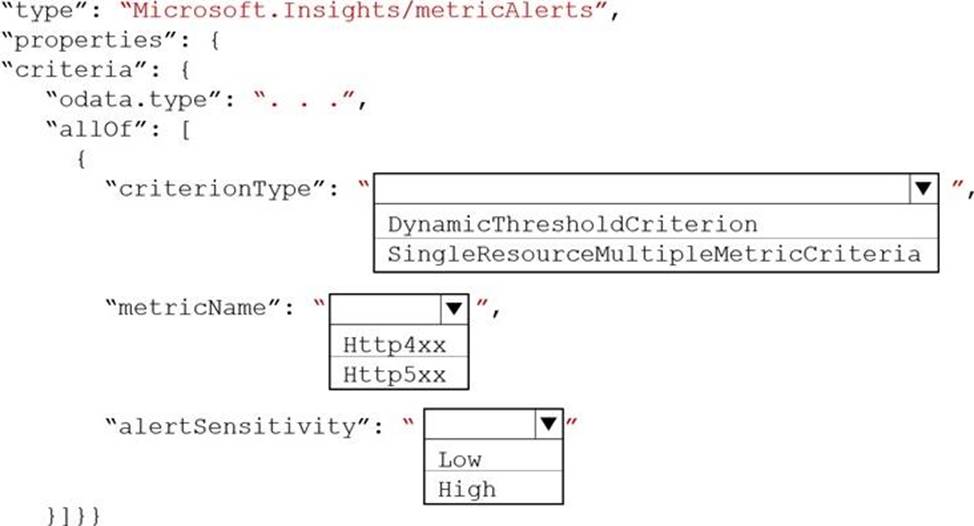
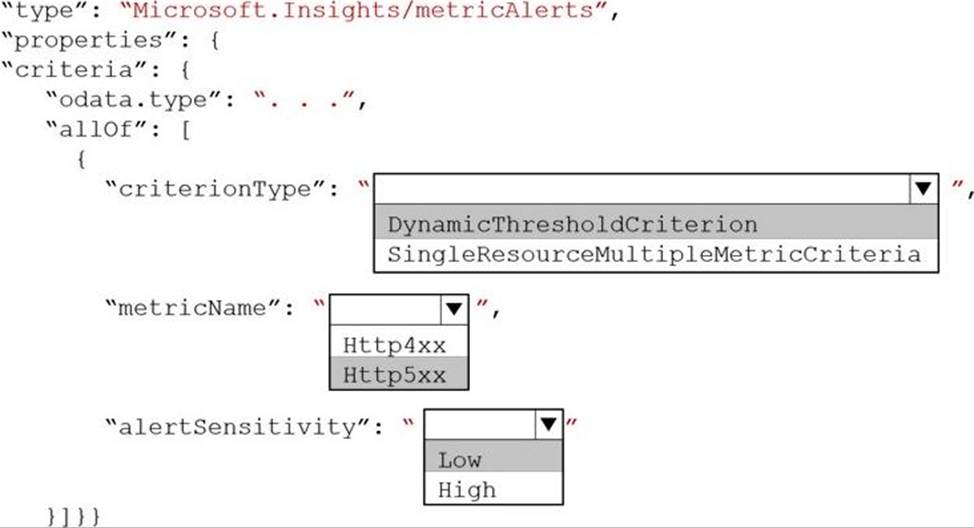
Explanation:
Box 1: DynamicThresholdCriterion
Box 2: Http5xx
Server errors are in the 5xx range.
Client errors are in the 4xx range
Box 3: Low
Reference: https://docs.microsoft.com/en-us/azure/azure-monitor/alerts/alerts-dynamic-thresholds
